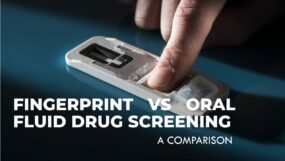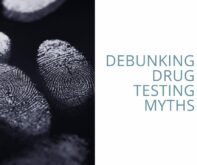It’s time for firms to get serious about tackling employee drug driving
05.03.2022

It’s time for firms to get serious about tackling employee drug driving
by Terry Elvin, www.intelligentfingerprinting.com
In 1999 an article in The Guardian described cocaine as the ‘currency of the capital’, and a drug that ‘was consumed with the casualness of an After Eight mint’. However, back then it was still regarded as largely the preserve of affluent professionals.
Step forward 20 plus years, and it’s a different world. Cocaine has had a rebrand, improving in quality and becoming widely available across society, from delivery drivers to directors. This not only reflects a growth in UK demand, but also shows how cocaine is increasingly being used by people from across the socio-economic scale.
EU drug research has found that the UK is Europe’s biggest user of cocaine, while UK Addiction Treatment (UKAT) reports that some 1.5 million people in Britain are dependent on benzodiazepine through prescribed drugs. Government research also suggests that one in eight people under 35 uses cannabis, while the Fleet Operator Recognition Scheme (FORS) reported that approximately 60-70% of substance users are in full-time employment.
This scale of drug use has an impact across all aspects of life. One area that is coming under increased scrutiny is drug driving, where there has been continued growth in arrest figures since drug driving impairment was added to The Road Traffic Act in 2015. The increase in drug driving should be a matter of concern for all employers, particularly where staff use their own or the firm’s vehicles for company business.
Increased drug driving across the UK and Ireland
2019 was the first year that UK police forces started to note that the number of arrests for drug driving was running ahead of those for drink driving. Cheshire Police, for example, reported that cannabis and cocaine were the most prevalent drugs being used by drug drivers, while 13% of those drivers taking roadside tests were found to be positive for both substances.
It has been a similar story in Ireland, where the Medical Bureau of Road Safety (MBRS) reported that drug driving incidents for the first quarter of 2021 were up 11% compared to 2020. Cannabis was the most prevalent drug detected in drug driving incidents, with 60% of roadside tests returning a positive result for cannabis and 30-40% of those also testing positive for cocaine.
Ignoring employee drug driving simply isn’t an option
The scale of drug use and the growth in drug driving means that businesses can no longer ignore the issue. According to BookMyGarage.com research, the number of drug driving charges across England and Wales increased by 125% between 2015 and 2020. So it’s hardly surprising that the FORS urged fleet operators to be extra vigilant about managing drug and alcohol impairment.
Analysis from the National Road Policing Intelligence Forum (NRPIF) has found that drugs can affect driving in several ways, including slow reaction times, erratic and aggressive behaviour, an inability to concentrate properly, nausea, hallucinations, panic attacks, paranoia and tremors as well as dizziness and fatigue.
Health and Safety professionals also need to be aware of the potential impact of the pandemic and lockdown on their employees. In the Global Drug Survey, 44% of UK respondents said they had used cannabis more frequently compared to before the pandemic. With employees now largely returned to work, it’s incumbent on HR and Health and Safety professionals to consider the potential impact of this on safety in the workplace.
Workplace drug use can not only put the well-being of individual employees at risk, but also their colleagues and the general public – particularly in key sectors such as public transport or logistics. Indeed, UKAT research suggested that substance abuse contributes to 40% of workplace accidents, while discussions at a recent HSE EU Congress suggested that the estimated annual cost of drug and alcohol misuse to UK businesses is around £36 billion!
FORS highlighted the importance for both operators and drivers to effectively manage the risks caused by drugs and alcohol across their operations. They particularly stressed the need to have clear Health and Safety policies and robust testing for drug and alcohol abuse in place to ensure employee welfare, the safety of other road users as well as members of the public.
Rise in drug driving places an increased focus on employee drug testing
Employee drug testing has an important role to play in underpinning an active and effective workplace drug policy. Testing regimes can vary and they need to be clearly defined within a company’s policy. These can range from pre-employment screens to post-incident or for cause investigations, and may also include random testing of all employees – or simply those in safety-critical roles. And while drug screening is valuable in terms of promoting health and safety within the workplace, implementing such a programme can prove challenging when using traditional tests that involve the collection of urine or saliva samples. There is also a growing view that these approaches may take up more time, planning and expense than is needed to support a company’s drug screening policy.
Organisations need to think carefully about selecting the drug testing approach that best meets their specific requirements. Workplace drug testers will know, for example, that urine or saliva testing can be unhygienic, time-consuming and undignified. They will also recognise that the longer window of detection offered by urine testing can be less beneficial for fitness for duty testing as drug use several days earlier – at the weekend, for example – may be detected, even though the employee is no longer under the influence at the time of testing.
For urine-based tests, sample collection is sometimes observed to reduce the chance of sample adulteration or substitution. This requires gender-specific staff and specially prepared collection areas, not only increasing the cost of screening but also limiting an employer’s ability to carry out spontaneous or off-site tests. While oral fluid (saliva) testing is simpler and more versatile than urine screening, saliva remains a biohazard and can prove difficult to collect if an individual has a dry mouth – a common side effect of many drugs, both illicit and clinically prescribed.
Urine and saliva tests also present an issue when testers need to dispose of samples once a drug screening test is complete. Handling and disposing of biohazardous body fluids and bulky body fluid collection kits is an unpopular, messy task that adds to the cost of each test. Many organisations have also found these traditional drug testing methods challenging to operate during the pandemic. Oral fluid tests require the collection of an individual’s saliva in close proximity, with no mask, while urine drug tests also involve the handling of messy and biohazardous samples. If organisations are to remove some of the barriers that get in the way of more flexible testing for drug driving, then a simpler, quicker, more cost-effective and less invasive approach to workplace drug testing is needed.
Driver drug testing in the workplace – need for a more agile approach?
Intelligent Fingerprinting’s non-invasive drug testing solution, based on fingerprint sweat analysis, brings new levels of convenience, hygiene and speed to workplace drug testing – making it an ideal solution for drug driving tests for all companies that have staff who drive for business. This includes those firms that have staff who drive for business, including using their own vehicles occasionally/regularly, or who use fleet vehicles – whether for deliveries, field-based roles or logistics.
Using a compact, portable reader and the tamper-evident drug screening cartridge, it takes under a minute to collect the fingerprint sweat sample, with on-screen test results for cocaine, opiates, cannabis and methamphetamine provided in ten minutes. Key benefits include:
- Quick-and-easy – sample collection in seconds, with on-screen results in 10 minutes
- Hygienic – non-invasive and non-biohazardous approach
- Portable and dignified – making non-intrusive, anytime almost anywhere testing a reality
- Cost-effective and efficient – enabling rapid in-house testing with no need for special facilities or specialist staff
- Ideal detection window – fingerprint testing’s shorter window of detection (within around 16 hours of the test), provides a clearer insight into fitness for duty at the time of the test, making it ideal for workplace screening
- One-stop solution – supported by a laboratory confirmation service if needed
The Intelligent Fingerprinting approach also enables both the test supervisor and the person being tested to remain socially distant at all times. Users can self-administer their own fingerprint sample collection, allowing them to keep at least 2m away from the tester. This can make a huge difference as it removes the need for prolonged proximity during testing.
Intelligent Fingerprinting in action:
- ParkerSteel, a leading UK steel stockholder and processor working with manufacturing and construction firms – has deployed fingerprint drug testing as part of its continued health and safety initiatives. The company uses Intelligent Fingerprinting’s drug screening system to encourage employee adherence to its drug safety policy – including HGV drivers in charge of up to 40-tonne steel loads. Replacing ParkerSteel’s previous use of urine tests, fingerprint testing now supports drug testing for new employee induction, random, just cause and post-incident. The flexibility of the system has enabled ParkerSteel to conduct random drug tests when drivers pause their HGV-loaded journeys to check that their load is safe, with tests conducted on-site and completed within minutes
- Quartzelec – a leading provider of engineering services – is rolling out fingerprint drug testing to some 450+ UK-based employees. Because the company has a large number of field-based engineers, it would have been time-consuming and disruptive to have them all come to one site for testing. With Intelligent Fingerprinting’s portable solution, Quartzelec is now able to test anywhere, conducting from 1 to 100 tests on-site as required – and it only takes minutes to collect a sample. The fingerprint drug test also enables Quartzelec’s Safety, Health, Environment and Quality (SHEQ) advisors to mobilise quickly whenever a test needs to be conducted quickly.
More Information
Any questions? Contact me to find out how fingerprint drug testing could bring new levels of convenience, speed and dignity to drug testing within your organisation.



